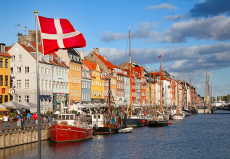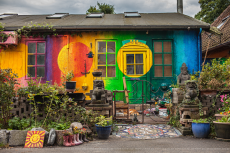
Copenhagen is the capital city of Denmark, as well as its cultural, economic and governmental centre. The city is a popular tourist destination, as well as a university city, and is one of the most interesting and beautiful places I’ve been lucky enough to travel to.
Located on Zealand, the largest and most populated island in Denmark, Copenhagen started as a fishing village in the 10th century. Traces of its medieval part can be found in the oldest section of the city, which is often referred to as Middelalderbyen, or the Medieval City. Amagertorv square, part of the Strøget area, is one of the oldest and is named for the Amager farmers who came to sell their wares at this site in the Middle Ages. The surrounding streets are pedestrianised, and are great for shopping; there is a huge Lego Store, as the popular toy was invented in Denmark.
Copenhagen became an important European regional centre during the 17th century, when it was the capital of the joint kingdom of Denmark and Norway. Many of its famous sights date from this era, when architecture was an expression of the kingdom’s prestige. Rosenborg Castle was built in 1606, in the Dutch Renaissance style, as a summer residence for the Danish royal family. The grounds of the castle, the King’s Garden, are the oldest and most frequented of the city’s many parks, and serve as a sculpture garden. The Rundetårn or Round Tower was built in 1635, and is Europe’s oldest functioning observatory. It has an equestrian staircase, or a large ramp, instead of stairs up to the observation deck. From here you get a great view of the old part of the city.
Copenhagen went through a period of redevelopment following a plague and fire in the 18th century. Most notable was the construction of the prestigious district of Frederiksstaden. Built during the reign of Frederick V, this district is considered one of the most important examples of rococo architecture in Europe. In its centre are the Amalienborg palaces, the winter home of the Danish royal family. These four identical palaces were built in a classical style with rococo interiors, and now house a museum about the Danish royalty. The focal point of Frederiksstaden is the Marmorkirken, the Marble Church, completed in 1894, which has the largest church dome in Scandinavia. South of this district is the iconic Nyhavn canal, famous for its colourful 17th and 18th century houses (pictured).

The 18th century also saw the development of Slotsholmen, an island in the city centre. Christiansborg palace was built on the site of the city’s first castle, dating back to 1167. Its ruins can be visited beneath the current palace. Slotsholmen is also known as the Island of Power, as this is where is the Danish Parliament, the Supreme Court, the Prime Minister’s Office and the State Rooms of the Queen are located.
Christianshavn is an area to the southeast of the inner city. It was developed by Christian IV in the early 17th century, with Amsterdam-inspired canals. One of the most prominent features of this area is Freetown Christiana. This self-proclaimed autonomous neighbourhood was created in 1971 when hippies started a squat in an old military area. Today it is famous for its beautiful and interesting buildings, workshops, art galleries and music venues (pictured).
The Vesterbro area to the southwest of the city begins with Tivoli Gardens, a huge amusement and pleasure park. Opened in 1843, it is the second-oldest amusement park in the world, and even inspired Walt Disney with his Disneyland design. The creator, Georg Carstensen obtained permission from King Christian VIII by telling him that "when the people are amusing themselves, they do not think about politics." Tivoli is most well-known for its wooden roller coaster, one of the world’s oldest wooden roller coasters, and for having the world’s second tallest carousel, The Star Flyer.
Finally, the most famous attraction in Copenhagen is the Little Mermaid Statue, built in 1913 on a rock by the waterside at Langelinie promenade. It is based on the fairytale by Hans Christian Anderson, one of Denmark’s most famous writers.
Images: https://cdn1.vox-cdn.com/thumbor/gU9wk7T2UJt3xsMOJSo5OwbL2SM=/cdn0.vox-cdn.com/uploads/chorus_asset/file/4163702/shutterstock_163182242.0.jpg
http://zocky.me/wp-content/uploads/2012/09/chr1.jpg

0 Comment:
Be the first one to comment on this article.